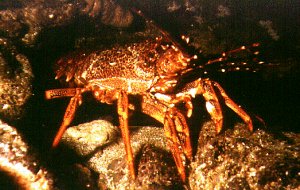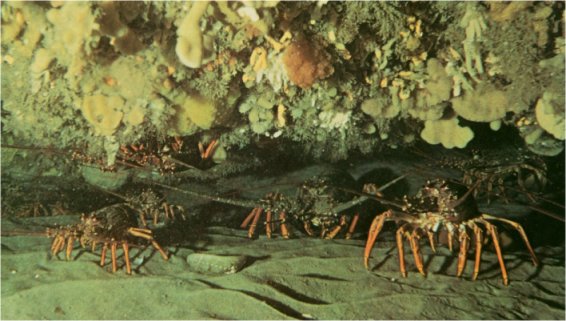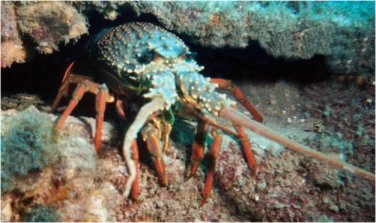 While commonly referred to as Crayfish in New Zealand, Spiny Rock Lobster is the more correct terminology for this fish.
While commonly referred to as Crayfish in New Zealand, Spiny Rock Lobster is the more correct terminology for this fish.
New Zealand has two common forms of rock lobster: Red or spiny rock lobster (Jasus edwardsii),
Red rock lobsters being the smaller of the two.
And the Green or packhorse lobster (Jasus verreauxi), being the larger.
The packhorse is also the world's largest rock lobster. It has been found as long as 60cm (2ft) and weighing 15kg (35lbs).
They are both widespred around the coasts usually between 5 - 100 mts (16 - 328ft) usually around reefs, though sometimes they are seen in groups over clear ground.
Rock lobsters usually move over a small area by night to search for food and shelter. By day they hide in their shelters.
Both species have a hard shell as for protection, unfortunatly this becomes a problem when it comes to growing.
During moulting periods rock lobsters often move to shallow waters.
To increase in size the rock lobster has to moult (shed), its shell and grow a bigger one.
It makes them very vulnerable while the new shell is hardening. Young rock lobsters moult several times a year, while adults moult annually.
Adult males moult between October and December, and females between February and May. Mating occurs within a few weeks of the female moult.
Rock lobsters grow for 7 to 10 years before becoming sexually mature. They can live for over 30 years. Their adult life is spent dwelling on the seafloor.
Rock lobsters can migrate in large numbers, often over open sea floor and during the day. Movements of up to 460 km (285mls) by red rock lobsters and up to 1070 km (664mls) by packhorse lobsters have been recorded. The reason for these migrations is not known.
One suggestion is that they may be to compensate for the drift of larvae since most of the long distance migrations observed have been in the opposite directions to prevailing currents.

Red crayfish are dark red and orange on top, paler and yellowish below.
The carapace has numerous small spines, and two long feelers. Adults can be up to 230 mm in length, measured along the carapace, with the male tending to be slightly larger than the female. The average size would be about 54cm (19in) total length and 5.4kg (12lbs) for the males, and 45cm (17in) and a weight of 2.3kg (5lbs) for the females.
These crayfish are found all around the coast of New Zealand. They mate between
February and May, and the female then carries the eggs under her abdomen for
4-6 months. These eggs are attached to fine hairs (setae) under the tail.
She uses the pincers on her hind legs to care for the eggs and later remove the empty egg sacs.
A large female may carry 3-400,000 eggs. The eggs hatch into planktonic larvae that drift out into the open ocean for up to 2 years. Finally the larvae change into pueruli, which resemble the adult body shape but are transparent. The pueruli swim in to the continental shelf and then settle nearer to the coast, in waters between 1m (3ft) and 200m (656ft) deep.
The crayfish reach maturity at between 3 and 5 years of age.
They feed, usually at night, on small crustaceans, sea urchins, sea stars, etc, and other bottom
dwelling life.
Their main predators include the octopus, moray and some other
fish species such as grouper (hapuka).

The packhorse can be distinguished by its much larger body size, smoother tail and its very broad carapace, only slightly shorter than the abdomen. They have an olive green body colour on the top sides, and a yellowish tinge on the underside, and brownish orange legs.
Their abdominal segments are smooth and unsculptured on their dorsal surface.
The packhorse males average size is between 40-60 cm (15-23in) total length and weigh in at at least 15kg (33lbs) the females being slightly less.
Packhorse rock lobsters are found in the Northen areas of the North Island between Cape Reinga, and just south of the Mahia Peninsula on the East cape. They sometimes are found in gradually reducing numbers to the south, but very rarely on the east coast of the South Island.
They generally move into deeper water in early winter, and return closer to the shoreline in late August.
They are most common on relatively open ground near Cape Reinga, which is the only known major breeding ground. In this vicinity of between North Cape and Cape Maria van Diemen in New Zealandís weatern far north great concentrations of juveniles have been found.
In saying all this studies of the packhorse crayfish by scientist John Booth of Fisheries Research indicate that long distance movements do occur, and it is possible that this species walks the entire length of New Zealandís west coast. Of 713 late juveniles tagged and released at North Cape, 122 were recovered. Most were around Cape Reinga, but four crayfish had moved south to the Cape Egmont area, a distance of 514 kilometres (319mls).